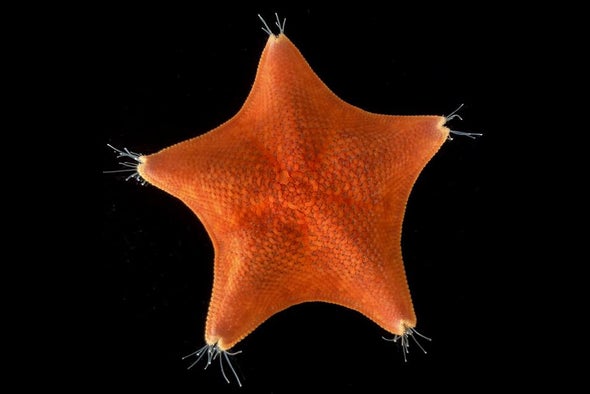
<div class="article-block article-text" data-behavior="newsletter_promo dfp_article_rendering" data-dfp-adword="Advertisement" data-newsletterpromo_article-text="
Sign up for Scientific American’s free newsletters.
” data-newsletterpromo_article-image=”https://static.scientificamerican.com/sciam/cache/file/4641809D-B8F1-41A3-9E5A87C21ADB2FD8_source.png” data-newsletterpromo_article-button-text=”Sign Up” data-newsletterpromo_article-button-link=”https://www.scientificamerican.com/page/newsletter-sign-up/?origincode=2018_sciam_ArticlePromo_NewsletterSignUp” name=”articleBody” itemprop=”articleBody”>
At first glance, starfish seem to be all limbs, with five appendages lined with rows of tube feet giving them their signature shape. Marine scientists have long wondered how they evolved to have such anatomy—and where their head might be.
It turns out that, genetically speaking, the animals are actually almost all head and no trunk, according to a new study published in Nature. The finding upends previous hypotheses about the body plans of starfish and is outright surprising, even to experts. “They’re all head?!” wrote Gail Grabowsky, a professor of environmental science at the Chaminade University of Honolulu, who wasn’t involved in the paper, in an e-mail to Scientific American. The results are “just super cool,” she added. Plus, they offer clues about how these creatures became such bizarre evolutionary exceptions.
The vast majority of animals are bilaterally symmetrical, or bilaterian, meaning a single line can divide their body into two identical halves. But starfish—as well as sand dollars and sea anemones—have radial symmetry, with identical segments of their body radiating out from a central point. In particular, starfish, also called sea stars, have fivefold radial symmetry, so the animal can be divided into five identical segments.
A set of molecular markers on a sea star’s genes determine the animal’s body plan, which includes its radial symmetry and organ structure. These genetic networks exist in all bilaterian organisms. But somewhere in their evolution, sea stars appear to have shaped themselves in a completely new way, resulting in a “weird” body that seems to diverge from the bilateral norm, explains study co-author Chris Lowe, an evolutionary biologist at Stanford University.
The same genetic markers that tell cells and tissues to form a head in one species can result in different anatomy in other species. The more closely related the species, the more likely they are to use the same genes for the same anatomy. But for evolutionarily odd animals, scientists have a hard time figuring out which parts of the anatomy are the head versus the trunk versus the tail because it’s not immediately obvious from how they look. Here, the term “head” broadly refers to the anterior of an animal. For some animals, that means a brain, but starfish don’t have that organ. Instead the head genes are involved in the development of the starfish’s nervous system and skin—features that are structurally different from a brain, even though they have the same genetic background.
To locate the parts of the starfish body where head-coding genes are active, the researchers compared the genetic markers in a small Patiria miniata sea star with Saccoglossus kowalevskii, a species of acorn worm that is closely related to starfish and that has a well-studied genome. Advances in laboratory techniques allowed the team to create a three-dimensional map of the genes that were expressed in thinly sliced samples of the starfish’s arms.
The researchers found that the genes in the head region of the acorn worm were “switched on” in the starfish’s bumpy skin, which covered its entire body. Those anterior genes were especially active at the center of each arm, whereas the genetic signatures became more posterior moving out toward the perimeter of each arm. And surprisingly, they entirely lacked the genetic patterning for a trunk, essentially the torso of an animal, says Lowe, whose work is funded by Chan Zuckerberg Biohub.
Basically, the starfish was all headlike. This contradicts textbook descriptions of echinoderms, the evolutionary group that includes starfish, as animals that have lost their head. This study shows that “rather than losing their head, they’re almost entirely head, and they’ve actually lost their trunk,” Lowe says.
“It’s a really, really interesting piece of work,” says Imran Rahman, a principal researcher at the Natural History Museum in London. “They’ve done a lot of careful analyses, and I found it very convincing.”
The study begins to probe a bigger evolutionary question: How did the sea star and its equally-strange echinoderm siblings develop their unique starlike symmetry? “It is a big mystery how this animal really evolved this shape,” says Paola Oliveri, a professor in developmental and evolutionary biology at University College London, who was not involved in the study. Millions of years ago, animals in this phylum—including starfish, brittle stars, sea cucumbers and sea urchins—were all bilateral. Today their bilateral larvae develop into their familiar five-axis structure as they grow, meaning that at some point, starfish dismantled all the genetic mechanisms of their bilateral ancestors.
“They reformed [that body plan] in a completely novel way, which explains why they’re so weird,” says the study’s lead author Laurent Formery, a postdoctoral researcher at Lowe’s lab at Stanford. But why and how this change occurred remains a mystery.
Beyond just sea stars, the findings may help scientists understand how new animal shapes and structures evolve in other branches of the tree of life, Oliveri says. They open up important research avenues about “how these animals develop and how they make this weird shape,” she says.
Next, the researchers will look to ancient fossils to find earlier sea star structures—perhaps some with more trunk and tail markers—to track when exactly the trunk was lost. The researchers also want to prove that the other echinoderms are covered in headlike regions as well.
“There’s more that can still be done to really confirm that this pattern extends across the whole phylum,” Rahman says. “Further analyses looking at different living species would help to clarify that.”
![]() Rights & Permissions
Rights & Permissions
